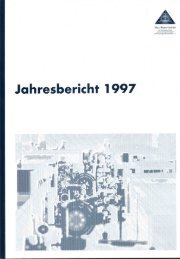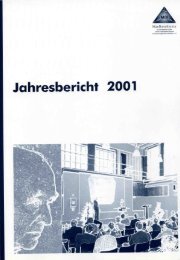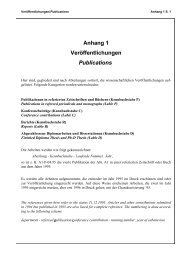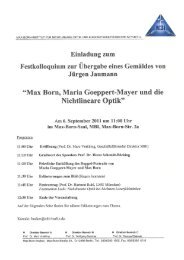Create successful ePaper yourself
Turn your PDF publications into a flip-book with our unique Google optimized e-Paper software.
40<br />
Fig. 9<br />
The probability of re-collision<br />
shown as a function of time<br />
following ionization. The laser<br />
electric field is plotted for<br />
convenience. The electron is<br />
most likely to re-collide about<br />
1.7 fs after it detaches.<br />
High-Harmonic Generation,<br />
Medical Tomography<br />
and Molecular Alignment<br />
<strong>Max</strong> <strong>Born</strong> • Paul Corkum<br />
our re-colliding electron has another important role besides orbital tomography – it produces<br />
short-wavelength coherent light.<br />
The re-collision electron has another application as well that we have already highlighted. Recollision<br />
electrons produce the shortest-duration light pulses (by a factor of ~ 20) that are currently<br />
produced [5, 6]. To make an isolated attosecond pulse, all we need is to shape the electric<br />
field [6] of the light pulse that is controlling the electron “beam-splitter” and the electron<br />
trajectory. For example, if we could produce a light pulse like that shown in Fig. 11, an ionizing<br />
electron would have only one option to re-collide – the electron would need to ionize near the<br />
first crest of the laser field and re-collide about 2/3 periods later. The blue arrow in the Fig. 11<br />
represents the most likely electron path and the blue pulse on the bottom of the frame represents<br />
the resulting attosecond pulse.<br />
While the pulse sketched in Fig. 11 is not a realistic pulse, the pulse shown in Fig. 5 is very<br />
similar and it is realistic. A pulse like that in Fig. 5 is used to produce single-attosecond pulses.<br />
The shortest pulse produced in this way is ~ 250 attoseconds [6].<br />
Ionizing pulses that are longer than the one shown in Fig. 5 can split the wave function many<br />
times. In such cases, a series of attosecond pulses separated by 1/2 period of the driving laser<br />
field are produced [6]. Mathematics tells us that this is equivalent to an array of harmonics of<br />
the driving laser frequency. The harmonics are spaced by twice the photon energy of the fundamental<br />
beam, since they are produced twice per laser period. They are odd-numbered harmonics<br />
of the laser because the electron re-collides from opposite sides every 1/2 period.<br />
Now we return to imaging, but with the knowledge that, if needed, our camera shutter can<br />
capture an image in a few hundred attoseconds.<br />
When a patient goes to the hospital for a tomographic image – a “CAT scan” – a medical technician<br />
records a series of two-dimensional X-ray images taken with the X-rays passing at different<br />
angles through the patient’s body. These two-dimensional projections contain enough<br />
information to reconstruct a 3-D image of the body.<br />
If we could align a molecule as if it were a patient, then multiple high-harmonic spectra,<br />
taken for different molecular alignments, would contain information about the electron in the<br />
same way that the multiple images in X-ray tomography tell us about a patient’s body. We<br />
could actually re-construct an image of the electron orbital from this spectrum. In the electron’s<br />
case, it would be an orbital image – the orbital from which the electron was split by<br />
tunnelling. So the critical question is, can we align a molecule like a patient is aligned in an












